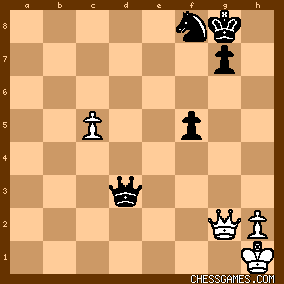| Jan-25-12 | | waustad: One should note that van Wely took the draw with just seconds on his clock. He did not have time to calculate Ra2 at the end, which was Houdini's choice. |
|
Jan-25-12
 | | Peligroso Patzer: FWIW, Houdini analysis on the official site (http://www.tatasteelchess.com/tourn...) gives <40. ... Ra2> as winning for Black from the final position, with the following as its main continuation: <41.Rg2 Rxg2 42.Qxg2 Rxd3 43.Rxd3 Qe1+ 44.Qg1 Qe4+ 45.Qg2 Qxd3>. I don't know how long the analysis was running; if for too short a time, it could be unreliable. Have not yet taken time myself to evaluate or try to understand the silicon analysis. |
|
| Jan-25-12 | | Caissanist: 42. Qxg2 loses a piece, but even after 42.Kxg2 black wins, according to Crafty (40. ... Ra2 41. Rg2 Rxg2 42. Kxg2 Rf4 43. Qc6 Rg4+ 44. Kf2 Qxh2+ 45. Ke3 Qf4+ 46. Ke2 Qh2+ 47. Ke3). Of course, it is easy to be smart after the fact, with unlimited time and an engine running. As it was, van Wely had been fighting for a draw for at least the past dozen moves, and was understandably unprepared to start playing for a win after the blunder 40. Qf3? Queen and pawn endings with both kings exposed can be very double edged. |
|
| Jan-25-12 | | capanegra: Agree with <Caissanist>. It was indeed bad luck for Van Wely to have a golden opportunity only at move 40 with a few seconds on his clock. If it were his 41 move, then he would have had 50 minutes instead of 50 seconds to think and find ♖a2. But to be fair, Radjabov also had few seconds for his 40 move. If it were his 41 move with more time to think surely he wouldn't have played ♕f3? and the position would have remained drawish. All in all, I believe a draw was a fair result. |
|
| Jan-25-12 | | engineerX: Nasty draw offer by white. |
|
Jan-25-12
 | | Penguincw: You got to give Van Wely credit. He's been drawing every game so far, but is picking up rating points along the way. So far, he's picked up 8 rating points. On Sunday, if he can draw Carlsen with the white pieces, he will pick up nearly 2 rating points. Otherwise, a win would earn 7 and a loss will lose just 3. |
|
| Jan-25-12 | | ajile: You don't see the Dutch Stonewall Defense much anymore. |
|
| Jan-25-12 | | hellopolgar: Loek Van Wely beat Teimour Radjabov 5 to 4, with 5 draws. well apparently LVW counters Teimour Radjabov. |
|
| Jan-25-12 | | notyetagm: Radjabov vs Van Wely, 2012 http://www.chess.co.uk/twic/chessne... <40.Qf3?

click for larger viewA blunder accompanied with a draw offer. Van Wely had only 50 seconds left and agreed to it. White has a couple of moves that should equalise. [<<<40.Qf3 Ra2 41.Rg2 Rxg2 42.Qxg2 Rxd3 43.Rxd3 Qe1+ 44.Qg1 Qe4+ 
click for larger view45.Qg2 Qxd3;

click for larger view>>> 40.Bf1 Rd2 41.Rh3 Rb4; 40.Rb2]> |
|
Jan-25-12
 | | Peligroso Patzer: <ajile: You don't see the Dutch Stonewall Defense much anymore.> Perhaps Van Wely thought it was a apt choice today, inasmuch as he is Dutch, and he was going for his tenth consecutive draw today against higher-rated opposition. Interesting for me has always been the dismissal by Alekhine (who played other Dutch systems) of the Stonewall Variation in his notes to Bogoljubov vs Tartakower, 1924, as follows: " *** Its sole advantage is that it renders Black’s position difficult of access; its disadvantages, on the other hand (condemning the queen’s bishop to passivity and weakening the black squares in a manner hardly to be remedied), are much more weighty. More alluring appears to be <4. Bb4+ 5. Bd2 Bxd2+ 6. Qxd2 Nc6>, followed by <… 0-0> and, eventually, <… d5> and <… Bd7>.” source: <New York 1924>, by Alekhine Alexander, Russell Enterprises, Inc. ©2008, at p. 224. |
|
| Jan-28-12 | | notyetagm: Game Collection: LOOSE SQUARES NEAR THE ENEMY KING |
|
| Jan-29-12 | | norami: The line by Caissanist ends with a repeat of the position. Draw? |
|
| Aug-14-12 | | fisayo123: Here is a video of Topalov laughing at Radjabov offering a draw in this position. |
|





































